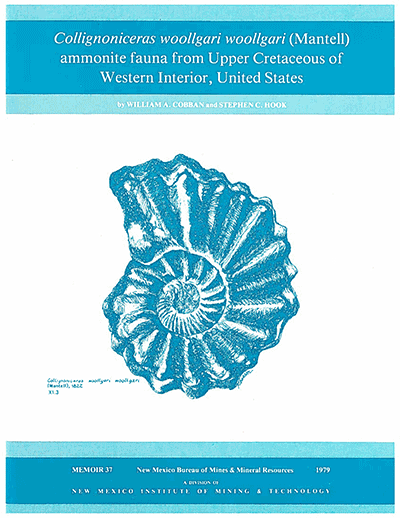
Memoir 37—Collignoniceras woollgari woollgari (Mantell) ammonite fauna from Upper Creataceous of Western Interior, United States
By W. A. Cobban and S. C. Hook, 1979, 51 pp., 12 figs., 12 plates, 1 index.

Discusses the middle Turonian ammonite range zone of Collignoniceras woollgari woollgari (Mantell) in the upper part of the Mancos Shale tongue and the lower part of the Tres Hermanos Sandstone Member of the Mancos Shale in New Mexico and the Western Interior.
The middle Turonian ammonite range zone of Collignoniceras woollgari is known from Europe and North America as well as from Japan and Australia. In the Western Interior of the United States, the zone is divisible into an older subzone of C. woollgari woollgari and a younger subzone of C. woollgari regulare. Ammonites found with C. woollgari woollgari, and probably restricted to this subzone, include Mammites depressus Powell, Spathites rioensis Powell, Watinoceras cobbani Collignon, Hoplitoides cf. H. wohltmanni, H. cf. H. koeneni Solger, and the new species Tragodesmoceras socorroense. Ammonites associated with C. woollgari regulare, and probably restricted to this subzone, include Scaphites larvaeformis Meek and Hayden, Tragodesmoceras carlilense Cobban, and Binneyites carlilensis Cobban. The subzone of C. woollgari woollgari is best developed in NewMexico where ammonites are common in the upper part of the Mancos Shale tongue underlying the Tres Hermanos Sandstone Member of the Mancos Shale as well as in the lower part of this sandstone member. The subzone of C. woollgari regulare is best known from very fossiliferous concretions in the Pool Creek Member of the Carlile Shale in the Black Hills area of South Dakota, Wyoming, and Montana.
Rocks of middle Turonian age are very fossiliferous at many localities in the Western Interior of the United States. Two associated species of ammonites, Collignoniceras woollgari and Scaphites larvaeformis Meek and Hayden, have been used since 1938 as guide fossils to a faunal zone, although the importance of C. woollgari had been noted earlier. In more recent years, C. woollgari alone has served as the name bearer of the zone (e.g. Cobban and Reeside, 1952, p. 1,018).
Fossils collected in the past few years in New Mexico, Utah, Colorado, and Wyoming have revealed a two-fold division of the range zone of C. woollgari. The upper part of the zone is characterized by a highly variable form of C. woollgari that has been well documented by Haas and Matsumoto. This form, separated by Haas into a forma typica and the varieties crassa, intermedia, regularis, tenuicostata, praecox, and alata, are abundant and widely distributed in the Western Interior. Most of the associated ammonites have been described and illustrated in , recent reports. In contrast to the upper part of the range zone of C. woollgari, the lower part has been poorly known and is limited in its geographic distribution. The European form of C. woollgari characterizes this part of the zone. Only two of the associated ammonites range up into rocks that contain the younger form of C. woollgari. The purpose of this report is to document the little-known lower part of the range zone of C. woollgari.
Fossils in the subzone of Collignoniceras woollgari woollgari in the Western Interior vary according to lithology and locality. The most diverse faunas are in nearshore marine sandstone. In west-central New Mexico, the zone includes the lower part of the Tres Hermanos Sandstone Member of the Mancos Shale and the upper part of the underlying Mancos Shale tongue. Brown-weathering calcareous sandstone concretions in the Tres Hermanos Sandstone Member are often very fossiliferous and contain a varied molluscan fauna in the Carthage to D-Cross Mountain area.
$9.50
Buy
Now
Also available as a free download.
Download
| File Name | Size | Last Modified |
|---|---|---|
| Memoir-37.pdf | 7.10 MB | 01/19/2021 09:49:16 AM |



